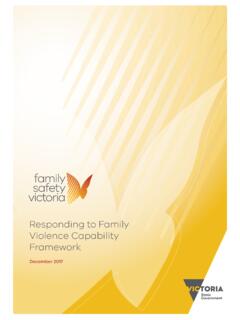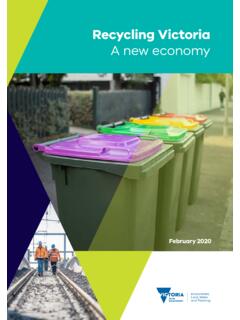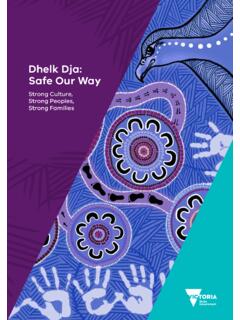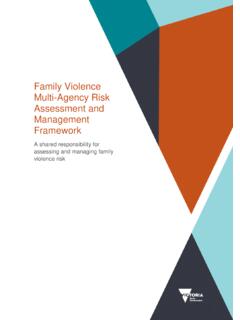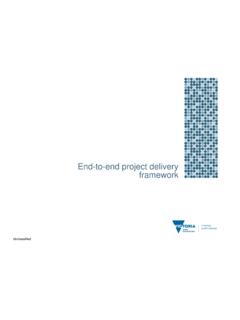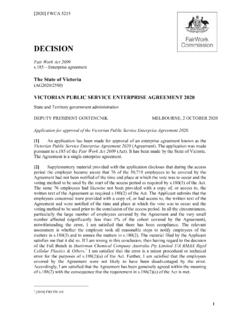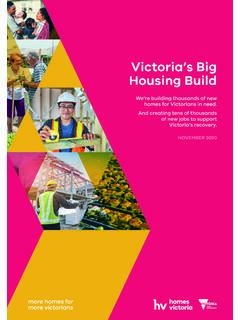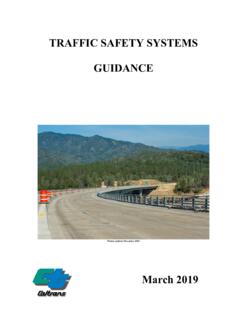Transcription of MARAM Practice Guides
1 MARAM . Practice Guides OFFICIAL. To receive this publication in an accessible format phone 1800 549 646, using the National Relay Service 13 36 77 if required, or email Authorised and published by the Victorian Government, 1 Treasury Place, Melbourne. State of Victoria, Australia, Family Safety Victoria, July 2019. In this document, Aboriginal' refers to both Aboriginal and Torres Strait Islander people. The Victorian Government proudly acknowledges Victorian Aboriginal people as the first peoples and Traditional Owners and custodians of the land and water on which we rely. We acknowledge and respect that Aboriginal communities are steeped in traditions and customs built on an incredibly disciplined social and cultural order. The social and cultural order has sustained up to 50,000 years of existence. We acknowledge the ongoing leadership role of the Aboriginal community in addressing, and preventing family violence and join with our First Peoples to eliminate family violence from all communities.
2 ISBN 978-1-925947-32-8 (pdf/online/MSword). Available at Page 2 MARAM Practice Guides OFFICIAL. Executive Summary Family violence is an endemic issue, which can have terrible consequences for individuals, families and communities. The Victorian Government launched Australia's first Royal Commission into Family Violence in February 2015 to address the scale and impact of this crime in Victoria. The Royal Commission into Family Violence (the Commission) held 25 days of public hearings;. it commissioned research and held community conversations with more than 800 Victorians. It also received almost 1000 written submissions. The Commission provided a once-in-a- generation opportunity to examine our system from the ground up and put victim survivors at the centre of family violence reform. The Commission delivered its report in March 2016, with 227 recommendations. The Commission outlined a vision for a Victoria that is free from family violence, where adults, young people and children are safe and where their wellbeing and needs are responded to, and where perpetrators are held to account for their actions and behaviours.
3 Where family violence does occur, the Commission outlined how reform of the service system could provide consistent, collaborative approaches to risk identification, assessment and management. The Commission noted the strong foundations of the service system and Practice environment that had been built by the Family Violence Risk Assessment and Risk Management Framework, also known as the Common Risk Assessment Framework or CRAF. To address key gaps and issues, it recommended a review and redevelopment of the CRAF, and to embed it into the Family Violence Protection Act 2008 (Vic) (the FVPA). The Victorian Family Violence Multi-Agency Risk Assessment and Management Framework ( MARAM Framework) updates and replaces the CRAF and is informed by consultations with more than 1650 practitioners and subject matter experts, and evidence-base reviews. In addition to the Commission's findings and recommendations, the redevelopment was also informed by the Coronial Inquest into the death of Luke Geoffrey Batty and the 2016 Review of the CRAF.
4 More than 855 organisations and 37,500 professionals are currently prescribed to align their policies, procedures, Practice guidance and tools to the MARAM Framework. 1 Further organisations will be prescribed from 2020. Fundamental changes identified by the Commission are reflected in the aims for the MARAM . Framework. These include: Increase the safety of people experiencing family violence Ensure the broad range of experiences and spectrum of risk are represented, including for Aboriginal and diverse communities, children, young people and older people, across identities, and family and relationship types Keep perpetrators in view and hold them accountable for their actions and behaviours Alignment of Practice across a broad range of organisations who have responsibilities to identify, assess and manage family violence risk Ensure consistent use of the Framework across organisations and sectors. The MARAM Framework outlines: 1. As at July 2019. A full list of organisations currently prescribed is available at information-sharing-schemes-and-risk-man agement-framework.
5 MARAM Practice Guides Page 3. OFFICIAL. An approach to Practice which is underpinned by the Framework Principles Four conceptual pillars' for organisations to align their policies, procedures, Practice guidelines and tools Information to support a shared understanding of the experience of risk and its impact on individuals, families and communities Expectations of Practice that are underpinned by a shared understanding of the range of roles across the service system, and consistent and collaborative Practice An expansion of the range of organisations and sectors who will have a formal role in family violence risk assessment and risk management Practice . A summary of these elements is described in the Foundation Knowledge Guide (below) to provide background for individual professionals and services. This document contains the MARAM Practice Guides which underpin the MARAM Framework. These resources are provided in three volumes and are designed for use by professionals and organisational leaders: 1.
6 The Foundation Knowledge Guide which focuses on the legislative context, roles and interactions with the service system, risk factors, key concepts for Practice and presentations of risk across different age groups and Aboriginal and diverse communities. The Foundation Knowledge Guide is required reading for all professionals across leadership and governance, management and supervision to direct Practice roles . Professionals should be familiar with this introductory and supporting information prior to engaging with the MARAM responsibilities for Practice Guide 2. The responsibilities for Practice Guide reflects each of the ten responsibilities of Practice set out in the MARAM Framework. This guide focuses on how to apply foundation knowledge and then build on this to provide Practice guidance from safe engagement, identification of risk, through levels of risk assessment and management, secondary consultation and referral, information sharing, and multi-agency and coordinated Practice .
7 Professionals' responsibilities will vary based on the nature of their role within a service or organisation and will be informed by the contact they may have with victim survivors and perpetrators. Professionals should work with their organisational leaders to understand their role and to identify which responsibilities they should be applying in Practice . Professionals are required to be familiar with each of the responsibilities that are a part of their role 3. The Organisation Embedding Guide supports organisational leaders to effectively support professionals and services to undertake their roles and responsibilities . This will link the work undertaken by professionals and services to the alignment of organisations' policies, procedures, Practice guidance and tools under the MARAM Framework. Professionals in leadership or management roles should be familiar with the Organisation Embedding Guide. In addition to responding to the requirements for alignment under the MARAM .
8 Framework, organisational leaders should assist professionals and services within their organisations to identify and use the Practice Guides appropriate to their roles . All MARAM tools and Practice Guides were developed through extensive consultation with a range of stakeholders including experts, departmental policy and Practice areas, and professionals in specialist and universal services, including those specialising in working with Aboriginal communities, diverse communities, children, young people and older people. The Guides will continue to be updated and evaluated to reflect the evolving evidence-base relating to experiences of family violence across the community and shifting Practice directions that will contribute to this evidence base. Page 4 MARAM Practice Guides OFFICIAL. Foundation Knowledge Guide MARAM Practice Guides : Foundation Knowledge Page 5. OFFICIAL. Contents Foundation Knowledge Guide .. 7. 1. Introduction .. 7. 2. A Principles-Based Approach to Practice .
9 8. 3. Legislative, Policy and Practice Environments .. 9. 4. Who has a Role in the Service System? .. 12. 5. MARAM Practice responsibilities for 13. 6. How can Victim Survivors or Perpetrators Access or Interact with the Service System? .. 18. 7. About Family Violence .. 19. 8. Evidence-based Risk Factors and the MARAM Risk Assessment Tools .. 22. 9. Key Concepts for Practice .. 28. 10. Presentations of Family Violence Across the Community .. 37. 11. Working with Perpetrators of Family Violence .. 56. 12. What's next? .. 61. 62. Note: Guidance and learning objectives for working with perpetrators is in development and will be available late 2019/early 2020. Finalised guidance will make clear that only key/selected professionals and services will be trained/required to provide a service response to perpetrators related to their use of violence. The learning objective for this Foundation Knowledge Guide will build on the material in this guide and will also include information about use of violence by perpetrators across the community and adolescents who use family violence.
10 Page 6 MARAM Practice Guides : Foundation Knowledge OFFICIAL. Foundation Knowledge Guide 1. Introduction The purpose of this Foundation Knowledge Guide is to provide professionals and services with information that explains key elements of the MARAM Framework, as well as additional foundational knowledge to guide all professionals before using the responsibilities for Practice Guide. The MARAM Framework provides evidence-based information about the impact and experience of risk across a range of age groups, as well as in Aboriginal communities and diverse communities. This information builds on the findings and recommendations of the Commission and establishes the shared responsibility for consistent early identification, screening, risk assessment and management of family violence, across a wide range of workforces and services. The MARAM Framework creates a shared responsibility between individual professionals, services and whole sectors. This allows the service to provide more options to keep victim survivors safe, and for a stronger, more collaborative approach that can keep perpetrators in view and accountable for their actions and behaviours.
